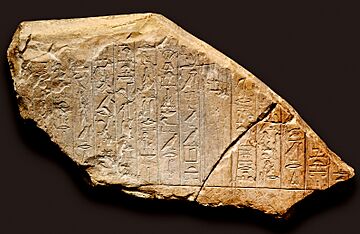Eighth Dynasty of Egypt facts for kids
Quick facts for kids
Eighth Dynasty of Egypt
|
|||||||||||||
|---|---|---|---|---|---|---|---|---|---|---|---|---|---|
| ca. 2181 BC–ca. 2160 BC | |||||||||||||
| Capital | Memphis | ||||||||||||
| Common languages | Egyptian language | ||||||||||||
| Religion | ancient Egyptian religion | ||||||||||||
| Government | Absolute monarchy | ||||||||||||
| Historical era | Bronze Age | ||||||||||||
|
• Established
|
ca. 2181 BC | ||||||||||||
|
• Disestablished
|
ca. 2160 BC | ||||||||||||
|
|||||||||||||
The Eighth Dynasty of ancient Egypt (Dynasty VIII) is a poorly known and short-lived line of pharaohs reigning in rapid succession in the early 22nd century BC, likely with their seat of power in Memphis. The Eighth Dynasty held sway at a time referred to as the very end of the Old Kingdom or the beginning of the First Intermediate Period. The power of the pharaohs was waning while that of the provincial governors, known as nomarchs, was increasingly important, the Egyptian state having by then effectively turned into a feudal system. In spite of close relations between the Memphite kings and powerful nomarchs, notably in Coptos, the Eighth Dynasty was eventually overthrown by the nomarchs of Heracleopolis Magna, who founded the Ninth Dynasty. The Eighth Dynasty is sometimes combined with the preceding Seventh Dynasty, owing to the lack of archeological evidence for the latter which may be fictitious.
Egyptologists estimate that the Eighth Dynasty ruled Egypt for approximately 20–45 years and various dates have been proposed: 2190–2165 BC, 2181–2160 BC, 2191–2145 BC, 2150–2118 BC.
End of the Old Kingdom and decline into chaos
The Eighth Dynasty has traditionally been classified as the first dynasty of the First Intermediate Period owing to the ephemeral nature of its kings' reigns as well as the sparsity of contemporary evidence, hinting at a decline of the state into chaos. Recent re-appraisal of the archaeological evidence has shown a strong continuity between the Sixth and Eighth Dynasties, so that Egyptologist Hratch Papazian has proposed that the Eighth Dynasty rather than the Sixth should be seen as the last of the Old Kingdom period.
Given that five Eighth Dynasty kings bore Pepi II's throne name Neferkare as part of their own names, they may have been descendants of 6th Dynasty, who were trying to hold on to some sort of power. Some of the acts of the final four Dynasty VIII kings are recorded in their decrees to Shemay, a vizier during this period, although only Qakare Ibi can be connected to any monumental construction. His pyramid has been found at Saqqara near that of Pepi II and, like its predecessors, had the Pyramid Texts written on the walls.
However many kings there actually were, it is clear that during this time period a breakdown of the central authority of Egypt was underway. The rulers of these dynasties were based in Memphis and seem to have relied on the power of the nomarchs of Coptos, on whom they bestowed titles and honours. This must have been to no avail as the Eighth Dynasty was eventually overthrown by a rival group based in Herakleopolis Magna.
Rulers
Given the lack of evidence for the Seventh Dynasty, all kings mentioned on the Abydos king list in the entries after that of Merenre Nemtyemsaf II and before that of Montuhotep II are usually attributed to the Eighth Dynasty. Following Jürgen von Beckerath, they are :
| Name | Comments |
|---|---|
| Netjerkare Siptah | Sometimes classified as the last king of the 6th Dynasty. Possibly identical with Nitocris. |
| Menkare | Possibly attested by a relief from the tomb of queen Neit. |
| Neferkare II | |
| Neferkare Neby | Planned or started a pyramid "Neferkare Neby is Enduring of Life", possibly at Saqqara. |
| Djedkare Shemai | |
| Neferkare Khendu | |
| Merenhor | |
| Neferkamin | |
| Nikare | Possibly attested by a cylinder seal. |
| Neferkare Tereru | |
| Neferkahor | Attested by a cylinder seal. |
| Neferkare Pepiseneb | Turin Canon gives at least one year. |
| Neferkamin Anu | |
| Qakare Ibi | Turin Canon gives rule of two years, one month, one day. Attested by his pyramid at Saqqara. |
| Neferkaure | Turin Canon gives rule of 4 years and 2 months, attested by a decree concerning the temple of Min. |
| Khwiwihepu Neferkauhor | Turin Canon gives rule of 2 years, 1 month and 1 day, attested by eight decrees concerning the temple of Min, and an inscription in the tomb of vizier Shemay. |
| Neferirkare | Turin Canon gives a reign of 1 and a half years. Maybe identical to either or both of Horus Demedjibtawy and Wadjkare. If so, he is attested by a decree concerning the temple of Min. |
The Egyptologist Hracht Papazian believes that such a reconstruction gives too much weight to Manetho's account, according to which the Seventh Dynasty is essentially fictitious and a metaphor of chaos. Instead Papazian proposes that the earliest of the above kings are immediate successors of Pepi II and should be attributed to the Sixth Dynasty, while those just after them belong to a short-lived Seventh Dynasty. Then the Eighth Dynasty would only start with the well-attested Qakare-Ibi:
| Name |
|---|
| Qakare Ibi |
| Neferkaure |
| Khwiwihepu Neferkauhor |
| Name lost |
| Neferirkare |
In addition, the identity and chronological position and extent of rule of the following rulers is highly uncertain: Wadjkare, Khuiqer, Khui and Iytjenu.


